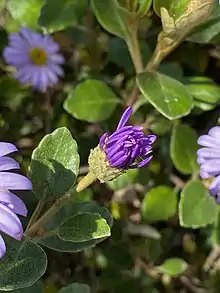Olearia tomentosa
Olearia tomentosa, commonly known as the toothed- or downy daisy bush, is a shrub or subshrub species in the family Asteraceae.[1]
| Olearia tomentosa | |
|---|---|
.jpg.webp) | |
| Scientific classification | |
| Kingdom: | |
| (unranked): | |
| (unranked): | |
| (unranked): | |
| Order: | |
| Family: | |
| Tribe: | |
| Genus: | |
| Species: | O. tomentosa |
| Binomial name | |
| Olearia tomentosa | |
| Synonyms | |
| |


German botanist Johann Christoph Wendland described it in 1798 as Aster tomentosus. The species name refers to its hairiness.[2] Augustin Pyramus de Candolle gave it its current name in 1836, placing it in the genus Olearia. It is the type species of the genus, and was placed in the section Dicerotriche yet genetically is sister to the section Asterotriche.[3]
The plant is a woody shrub or subshrub with an erect habit reaching anywhere from 2 m (6.6 ft) high, with furry stems and leaves. The oval leaves are alternately arranged along the stems and are up to 1–8.5 cm (0.39–3.35 in) long and 0.9–5 cm (0.35–1.97 in) wide with toothed or lobed margins, and sit on 1–5 cm long petioles. The upper leaf surfaces are dull green, while the leaf undersides are beige or pale grey. The flowers appear from August to May. The disc is yellow and rays are white or blue, the flower heads 2.5 to 5.9 cm (0.98 to 2.32 in) in diameter.[4]
Olearia tomentosa occurs in eastern New South Wales, where it is found south of the Hastings River, and Victoria.[4] It grows on sandstone-based soils in dry sclerophyll forest and heath.[5]
Olearia tomentosa plants are generally killed by bushfire, though there are reports of plants regrowing from suckers after fire.[5]
Not commonly seen in cultivation, Olearia tomentosa grows in soil with good drainage in a sunny or part-shaded location. Regular pruning prevents the plant from becoming leggy,[2] and can rejuvenate older plants. The species is moderately frost-hardy.[6]
References
- "Olearia tomentosa (J.C.Wendl.) DC". Australian Plant Name Index (APNI), IBIS database. Centre for Plant Biodiversity Research, Australian Government.
- Walters, Brian. "Olearia tomentosa". Plant Guide. Australian Native Plants Society (Australia).
- Cross, E.W.; Quinn, C.J.; Wagstaff, S.J. (2002). "Molecular evidence for the polyphyly of Olearia (Astereae: Asteraceae)". Plant Systematics and Evolution. 235 (1–4): 99–120. doi:10.1007/s00606-002-0198-9. JSTOR 23645039.
- Paul G. Wilson. "New South Wales Flora Online: Olearia tomentosa". Royal Botanic Gardens & Domain Trust, Sydney, Australia.
- Benson, Doug; McDougall, Lyn (1994). "Ecology of Sydney Plant Species Part 2: Dicotyledon families Asteraceae to Buddlejaceae" (PDF). Cunninghamia. 3 (4): 789–1004 [903–04]. ISSN 0727-9620. Archived from the original (PDF) on 2017-03-16.
- Elliot, Rodger W.; Jones, David L.; Blake, Trevor (1997). Encyclopaedia of Australian Plants Suitable for Cultivation. 7: N–Po. Port Melbourne, Victoria: Lothian Press. p. 98. ISBN 0-85091-634-8.